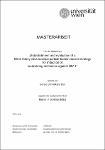Establishment and evaluation of a feline foamy virus subviral particle-based vaccine strategy for induction of neutralizing antibodies against HIV-1
Schneikart, Gerald
35 million people died due to the acquired immunodeficiency syndrome (AIDS) since the outbreak of the HIV pandemic. Despite intensive research, developing an immu-nogen to induce broadly neutralizing antibodies (bnAbs) against HIV remains a chal-lenge, although about 10 - 30 % of infected individuals develop bnAbs against HIV-1 on average 2.5 years after infection. Two of them are 2F5 and 4E10, targeting the membrane proximal external region (MPER) of the transmembrane envelope protein (TM) gp41. Previous studies on the non-pathogenic retrovirus feline foamy virus (FFV) revealed immunogenic regions with a bipartite motif in its TM protein, gp48, equivalent to the locations of the 2F5 and 4E10 epitopes in HIV gp41. In order to use the FFV TM protein as HIV epitope scaffold, the 2F5 and 4E10 epitopes were inte-grated into the full-length FFV Env backbone by replacing the equivalent sequences. After transfection of HEK293T cells, it could be shown that the chimeric FFV/HIV-1 proteins are produced and released into the cell culture supernatants. Furthermore, the secreted material has properties typical for subviral particles (SVPs). This is in line with the finding that FFV Env protein expression is sufficient to induce budding in absence of any other FV proteins. In order to allow evaluation of the potential of those hybrid SVPs as HIV-1 vaccines by administration in a DNA-prime/SVP-boost regimen in rats, sufficient amounts were required. In the frame of this thesis, efficient protocols for large-scale production of SVPs were established. This was achieved by subcloning the respective sequences into retroviral transfer vectors and systematic optimization of transfection, virus production and concentration protocols to obtain high titer stocks of infectious vesicular stomatitis virus protein G (VSV-G) pseudo-typed viruses. Transduction of various cell lines revealed CRFK cells as suitable pro-ducer cells for the production of the intended SVPs. Immunoprecipitation of the native antigens with mAb 2F5 and mAb 4E10 demonstrated that the respective epitopes are accessible. Application of transmission electron microscopy using the method of negative staining confirmed successful SVP production which was further optimized by testing different commercially available expression media. First steps to scale up the production process using Corning® HYPERFlasks® have also been accom-plished. The established protocols for large-scale production of hybrid FFV/HIV-1 SVPs carrying the 2F5 and 4E10 epitopes allow testing the potential of a novel re-combinant vaccine strategy against HIV-1 infections.
Files in this item
No license information

